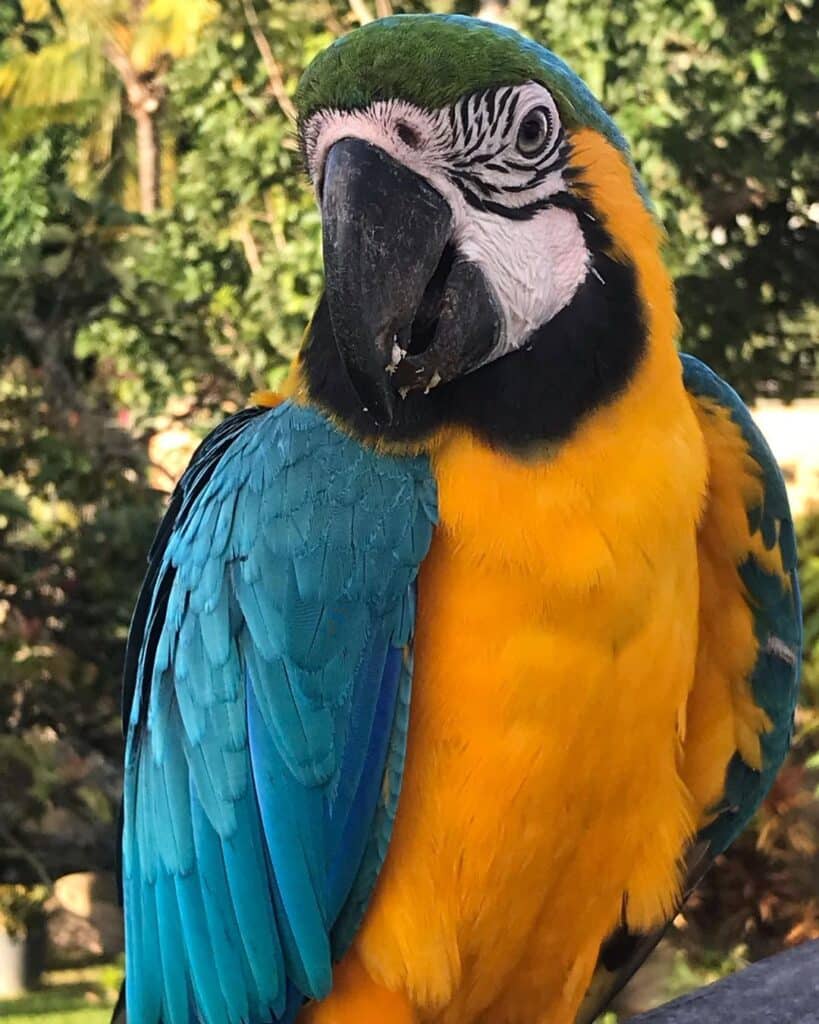Blue and Gold Macaw
The species Ara ararauna is a large parrot native to South America, commonly called the Blue and Gold Macaw or the Blue and Yellow Macaw. The bird is beautifully colored with blue feathers on the top and yellow ones on the underparts. The Blue and Gold Macaw belong to the larger family of Neotropical parrots collectively called macaws. The bird is found at large in forest regions (particularly várzea (Wiki: seasonally flooded forest), which are floodplain forests as well as the open spaces of terra firme, which are non-flooded types of forests) and the tropical woodlands of South America.

Description
The birds belonging to the macaw family are all vividly colored. Colorful as they come, the Blue and Gold Macaws are among the most beautiful of the lot. Streaked with a standout turquoise blue from the neck, over the back and till the tail tip is the feather coat. Gold feathers cover the chest region and legs. The face bears a bare patch with fine feathers running across the face. On the head right at the top is a patch of green feathers. The underside of the tail is covered with feathers of bright gold. The Blue and Gold Macaws have beaks that are black in color.
Habitat
The Blue and Gold Macaws are found in Venezuela and extending to the south in Bolivia, Brazil, Paraguay and Peru. In Central America they are found in parts of Panama. These birds were also found in the Caribbean island of Trinidad, but human activities caused their extinction from these regions after the 1970s. Wild caught birds were relocated from Guyana to the island of Trinidad between the years 1999 to 2003 in an effort to re-establish them as a protected species in the swamps of Nariva, a freshwater wetland of Trinidad and Tobago.
Reproduction
As is the case with most macaws, these birds generally mate their entire lifespan. Nests are made from exclusively dead palm leaves, mainly of the Mauritia Flexuosa variety of palms. Typically, a female bird will lay two to three eggs and incubate them for 28 days. After the eggs hatch, one chick dominates the others and makes good of most of the food provided. Thus the other chicks perish in the nest. The fledgling chicks are ready in about 97 days post hatching. The bright and bold color of the male bird is an indicator of being ready for breeding; brighter and bolder colors, increasing the chance of attracting a mate.
Rearing Blue and Gold Macaws at home
Domesticating Blue and Gold Macaws require attention towards the following needs of the birds, namely, food, proper cage and care.
Food
In their natural habitat, these birds feed on a varied mix of fruits, plants, seed, nuts and small insects such as tiny lizards. Domesticated pets can be a fed a commercially available branded feeds for Macaws. They can also be fed nutritious foods that are part of your diet. As a matter of fact, many parrots enjoy having a meal with their owners. They do enjoy chicken. Avocados and chocolates are foods that should be avoided as they are toxic to them.
Care
Regular baths are required for the Blue and Gold Macaws to prevent their feathers from losing too much moisture. Their natural habitat is humid; when kept for long without bathing, their feathers can become dry, causing them to itch and chew on the feathers. They can be sprayed with tap water at room temperature or any commercially available bird bath. Most owners also have the practice of having a shower along with their pet macaws. Special shower perches are made for the bird. Essential cage care includes day-to-day cleaning of the dishes used to place water and food in the cage. Weekly washing of the perches and toys and fortnightly washing of the floor of the cage are part of this routine. Yearly hosing down of the aviary followed by disinfecting it and replacing toys, old dishes and perched is also advised.
Cage requirements
The cage should be roomy for these large macaws, the minimum dimensions being two-and-half by three feet. As these birds can be pretty noisy, vocal and boisterous it is advisable to place the cage where it is going to cause the least bit of disturbance to the neighbors. The cage should also have an adequate-sized, sturdy perch. Fresh branches of fruit trees serve this purpose as the birds can also chew on them. These would, however, have to be replaced from time to time.

Having discovered a fondness for insects while pursuing her degree in Biology, Randi Jones was quite bugged to know that people usually dismissed these little creatures as “creepy-crawlies”.







